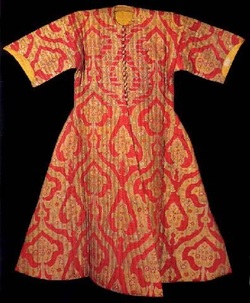
Unfortunately, this splendor is not often replicated in patterned textiles that are affordable to us as reenactors. It is rare to find a truly period Ottoman print, and even more rare to find that in a form that is either affordable or comfortable (i.e. a natural fiber).
To better recreate the extant garments (which one must also remember were often imperial property and were ceremonially worn by the sultan or were given by him as gifts), we have to do our best to wade through the maze of lovely (but often overly busy) quilting cottons or suffer through the potential heatstroke that can come from wearing fabric that is better suited to a sofa.
When I am, however, looking to find that elusive perfect fabric for new garb, I tend to take into account four things: Fiber, Color, Pattern & Scale. (And there is another category as well, UWYH. That stands for "Use What You Have". If you have something semi-suitable in your stash and are questioning buying more, or are just starting a new costume endevour, it never hurts to do a bit of stash-busting first while learning to make a new type of garb and then try to find that perfect fabric.)
Below and in several posts yet-to-come, I will discuss my own personal preferences and methods for selecting fabrics for my Ottoman garb and how I deal with the real world issues of money and inaccessible reproduction textiles.
Fiber
Fiber content is a key factor in the decision making process of many SCAdians. Most reenactors prefer garments that will be cool in hot weather and that will breathe well (something one will not get with polyester or acrylic fibers).
Silk was most often used for the imperial caftans, but there is at least one extant garment in wool that I have seen (and I would guess there are others). Linings were often linen or cotton or silk.
I personally often resort to plain linen for my SCA garments, even if that would not have been the preferred choice for that garment historically. Why? Because I know that I will get the most use out of garb that is comfortable to wear at summer events, particularly Pennsic. I also think that sometimes the solid colored garments are under-represented among Ottoman and Middle Eastern reenactors in the SCA (many miniatures show people in solid colored garments, and even some of the imperial garments are in a single color of silk).
However, if I find the "right" design, I will often purchase a synthetic fabric and use it to make my entari. The entari is a long coat, often worn over a shorter inner coat - the chirka, which in turn is worn over a gomlek (a sort of chemise). I know that if the outer coat becomes too uncomfortably hot, that I can remove it and still have my chirka and gomlek on. I am also more likely to use a synthetic for an event like 12th Night, which is in the winter, than I am to use it for a potentially humid event such as Pennsic.
Some people are less bothered by wearing synthetics than others so decisions about fiber content should always be based on personal comfort preference.
Silk was used in period by the Ottoman Turks, as was cotton, linen and wool. Additionally, Indian block printed cottons were imported at the time as a luxury (but I would not use these for a coat). Silks were made in the empires silk centers, but were also imported from Italy and elsewhere in Europe.
My choices in fiber - for solid colors - can be found below (in no particular order). (Note, these are my preferences for the things I often use myself or that I recommend to people who are looking to purchase fabric for new Ottoman garb.
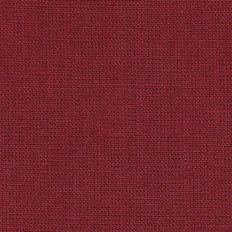
As I have said many times, I love linen. I particularly love to use this fabric in the 3.5oz weight (handkerchief weight) for my gomleks and undergarments. I also make my salwar out of this for Pennsic as it is very cool and comfortable and gives a nice drape at the ankles. I prefer the mid-weight (5.3 oz-6oz) for my coats. Do I think that linen is the absolute best choice for an Ottoman coat? No, but I do think it is more versatile for the average SCAdian.
Linen also comes in a wonderful range of colors, many are period for Ottoman clothing. It also makes for a nice lining inside a coat made from a synthetic or silk fabric.
My favorite sources are:
http://www.fabrics-store.com/
http://www.graylinelinen.com/
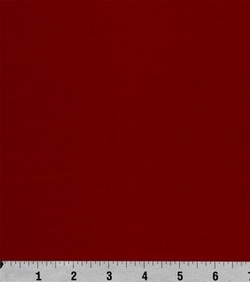
Cotton is perhaps the most affordable option for garb, and the easiest to find at your local fabric or quilt shop. It comes in broad range of colors and is even easy to dye yourself. It also comes in a plethora of prints (more on prints later).
Light weight cottons make wonderful gomleks and undergarments and even salwar. A quilting weight cotton can even make a nice coat (but I prefer to line the garment to add body and stability, especially if one is aiming for the snug-in-the-torso look). Occasionally one can even find a heavier weight printed cotton in the home decor section or a cotton twill in the apparel section that can make for a wonderful coat fabric.
One choice that I love if someone is looking for a cotton is a cotton sateen. I will note here today that often people categorize and cotton fabric with a sheen as sateen, and any other fiber with that same sheen as a satin. The difference in satin and sateen is actually in the weave structure, not the fiber content. (If you care to see diagrams of the difference, check out the diagrams here: http://stgeneve.com/quality_defines/covering/weave_types.htm ) A cotton sateen is affordable and has a nice luster (though not as rich as silk) and is not a bad option for a comfortable fabric for recreating Ottoman garb.
Resources for cotton sateen (one can also search online for fabric stores carrying this fabric, there should be quite a few and those carried by home decorating stores might have heavier sateens that will work even better for coats):
http://www.joann.com/sateen-solids/prd12710/
http://www.hancockfabrics.com/Cotton-Sateen_stcVVcatId539047VVviewcat.htm
Another fabric with a satin finish that is a cotton-silk blend that might be nice for garb (I personally have not used this one yet) is the cotton-silk poplin from Fabric.com: https://www.fabric.com/buy/bz-148/radiance-cotton-silk-poplin-cranberry
Another cotton option that has a luxury look, but is both comfortable and washable, is Cotton Velveteen. Velvet is period, and cotton velveteen, while not perfect, is a fair substitute for the rich silk velvets of the Ottoman empire.
Resources for cotton velveteen:
https://www.fabric.com/apparel-fashion-fabric-velvet-fabric-velveteen-velour-fabric-doux-cotton-velvet-fabric.aspx
http://www.joann.com/empire-velveteen-fabric/xprd728531/
If you are looking for sheer cottons to use for a gomlek, check out cotton voile. This fabric is light, airy and can produce the sheer look that shows up in many of the Ottoman miniatures (see image of palace women from I Turchi; Codex Vindobonensis 8626 below). Cotton is an appropriate material for these garments. https://www.fabric.com/buy/dj-385/cotton-voile-supreme-wide-white
One additional word about cotton, if you are looking for comfort avoid cotton/poly blends. Even if the fabric is light in weight, you will be doing yourself no favors by wearing it.
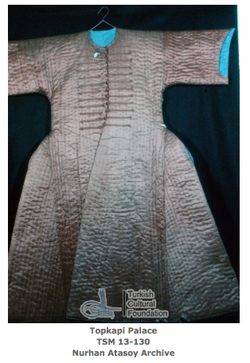 Quilted silk Caftan.
Quilted silk Caftan. Silk is still the ultimate luxury fabric (and often still carries a luxury price). Occasionally we can get silks that fall within our price range and occasionally those are even a good choice for reproducing period garb.
Silks were made in the empires silk centers, but were also imported from Italy and elsewhere in Europe. Real silk, however, is very pricey and I find it just as uncomfortable in humid weather as I do synthetics. The less costly silks are not always great for our recreations. Silk Noil (often called Raw Silk) was not used in period and has a very different look and texture than historic silks. When I occasionally still find some of this in my stash, and tend to use it in place wool for tunics and other early period European garments and look for something with more luster for my Ottoman clothing.
One often affordable silk is called China silk or habotai. This is a very light weight, plain weave silk that can work for a gomlek, veil or even very light weight pants. I would avoid using this fabric for a coat as it does not have the necessary body to recreate an Ottoman look, but it makes a nice lining fabric.
A resource I have used for Habotai is: http://www.thaisilks.com/
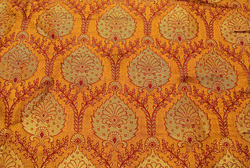 A silk "brocade" I bought on Etsy
A silk "brocade" I bought on Etsy 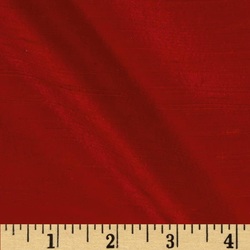
Resources for dupioni:
https://www.fabric.com/apparel-fashion-fabric-silk-fabric-dupioni-silk-fabric.aspx?Source=SubCategoryLink
http://www.thaisilks.com/
http://www.fabricmartfabrics.com/Dupioni/
For a coat weight solid silk I would recommend (if you have the $ to spend) looking for silk satin, taffeta or velvet. Silk satins and taffeta can often be found in high end fabric stores among the bridal and special occasion fabrics. Velvet can also be found there of in the home decor section.
Often one can find silk velvets that are a blend of rayon and silk (Thai Silks, mentioned above carries this textile) and you can also find attractive satin, taffeta and velvet as synthetics. (If you are looking for a more period satin that is synthetic, look to the better bridal satins rather than those destined to become Halloween costumes, the luster and weight of the two are quite different).
Another option that can occasionally be found is silk twill. You have to scout around for it, and get swatches to verify that it is really silk and that it is heaver than lining weight fabric.
Resource for silk tafetta/twill (this site typically has a small selection of 100% silk tafettas and occasionally silk twill): http://www.fabricmartfabrics.com/Taffeta/
Another type of tafetta that was available had a watermark pattern - often called moire. Silk moires are not easy to come by at this time, but synthetics with this distinct patterning can still be found in the home decorator or special occasion apparel departments of many fabric stores.
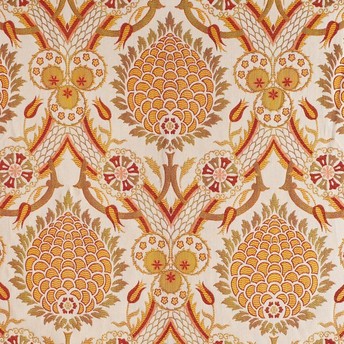 An unbelievably expensive, but amazingly period, fabric made from Viscose.
An unbelievably expensive, but amazingly period, fabric made from Viscose. Unfortunately, many of the best period patterns are offered only in synthetic fabrics and we have to make a choice to suffer in the man-made fabrics or opt for something else.
Some fabrics are confusion to those new to the textile world. Rayon and Viscose are made from cellulose rather than chemical compounds and can often be comfortable to wear. Polyester tends to wash well and last awhile, but does not breath at all and can melt if it gets too close to fire. Acetate is often used for synthetic tafetta, but can discolor if something is spilled on it and is terrible for changing color with sweat stains.
If you do not mind a synthetic, and come across and find something that looks real, I would never suggest that you not use it.
More to come soon concerning Color and Pattern & Scale!
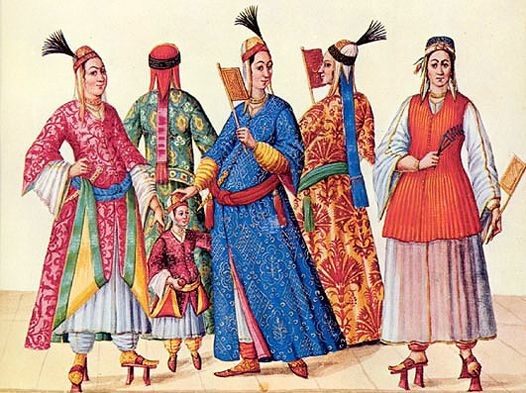
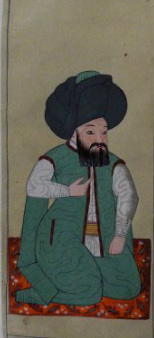
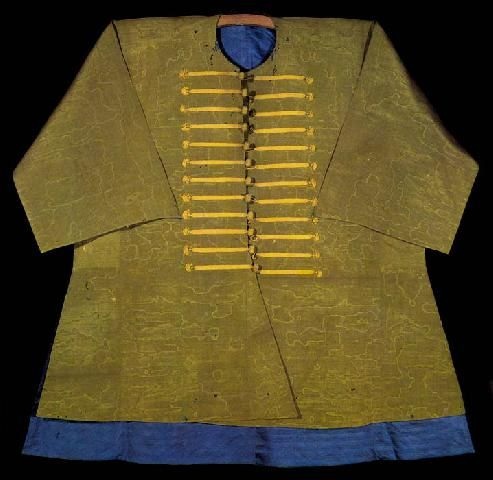
 RSS Feed
RSS Feed